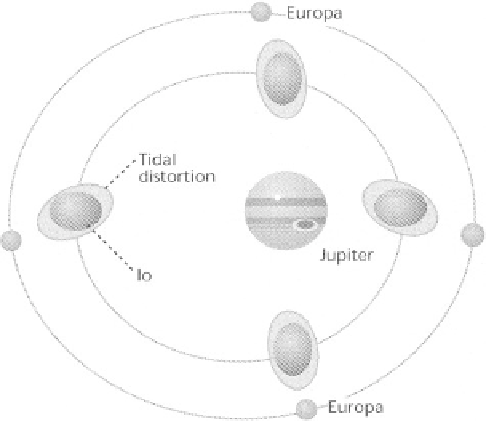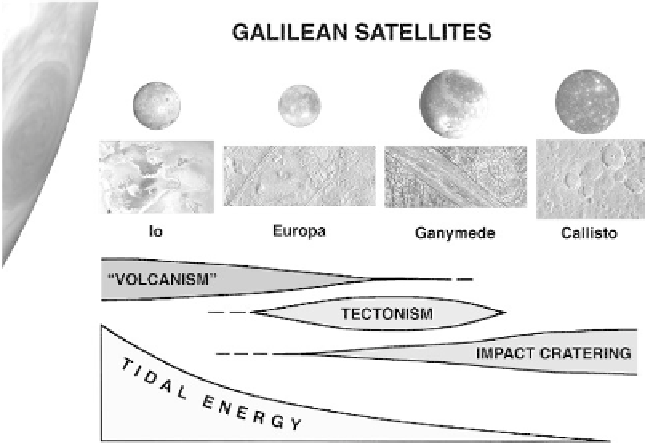Geology Reference
In-Depth Information
Linda Morabito, was analyzing the images and noticed
what appeared to be a smear extending from Io into the
dark sky
(Fig. 8.5)
.Her
first impulse was to dismiss the
feature as a
flaw in the image or an artifact of some sort
introduced during computer processing. A check with the
science team showed that this was not the case. With addi-
tional processing, the feature was found to be a plume of
gas and debris erupting from the volcano now named Pele.
Perhaps equally remarkable about the actual discovery
of volcanism was the prediction that volcanoes would be
found on Io. A team of geophysists had calculated the
amount of heat generated from Io
'
s tidal
flexing in its orbit
around Jupiter and determined that magma might be gen-
erated. They published their prediction of active volca-
noes just two weeks before the Voyager 1 image was
snapped. Such scienti
c serendipity is rare and serves as
an inspiration for all who seek new insight into how
planets operate.
Io
(Fig. 8.6)
is about the diameter of Earth
'
s Moon and
has a similar density, suggesting that it is a rocky object
with a small metallic core
(Fig. 8.4)
. It is the reddest object
in the Solar System, but its surface also includes pale
shades of brown, yellow, and orange. Galileo data and
observations from the Hubble Space Telescope and
Cassini provide a pretty good idea of what the various
colors represent. For example, SO
2
gas is a major compo-
nent of the eruptive plumes rising from Io
'
s surface. As the
gas condenses into solid ash, it rains onto the surface,
leaving diffuse, light-toned deposits around the volcanic
vents. Data also show that one molecular form of sulfur,
S
2
, is present in the eruptive plumes. However, this form
of sulfur is unstable in the cold environment of Io and
converts to two other molecular forms, S
3
and S
4
, both of
which are reddish orange. But the cycle is even more
complicated because these forms last only a few years
before converting to S
8
, which is yellow.
Figure 8.2. The orbits of Io and Europa are non-circular around
Jupiter (not drawn to scale). At times, Io draws close to Jupiter, then
pulls farther away. Coupled with interactions with Europa, this
results in a constant tug of war within Io, causing the rocks within the
moon to be pulled closer to Jupiter during the near part of the orbit,
with a relaxation during the distant part of the orbit. This tidal
flexing results in internal friction and the generation of enough heat
to melt the rocks below the surface, forming magma and fueling Io
'
s
active volcanoes. Similar tidal processes operate on Europa and
Ganymede, but with less intensity (from Greeley and Batson,
2001
).
Figure 8.3. A stylized diagram of the Galilean
satellites relating their dominant geologic
processes to the degree of tidal energy generated
by interactions among the moons and Jupiter. Io
experiences the maximum tidal stresses, resulting
in volcanism, while Callisto apparently
experiences little, if any, tidal stressing; thus
Callisto
s surface preserves the impact cratering
record from the early history of the Solar System.
Europa and Ganymede are intermediate cases,
with Europa showing some evidence for
cryovolcanism and Ganymede being extensively
modi
ed by tectonic resurfacing.
'




